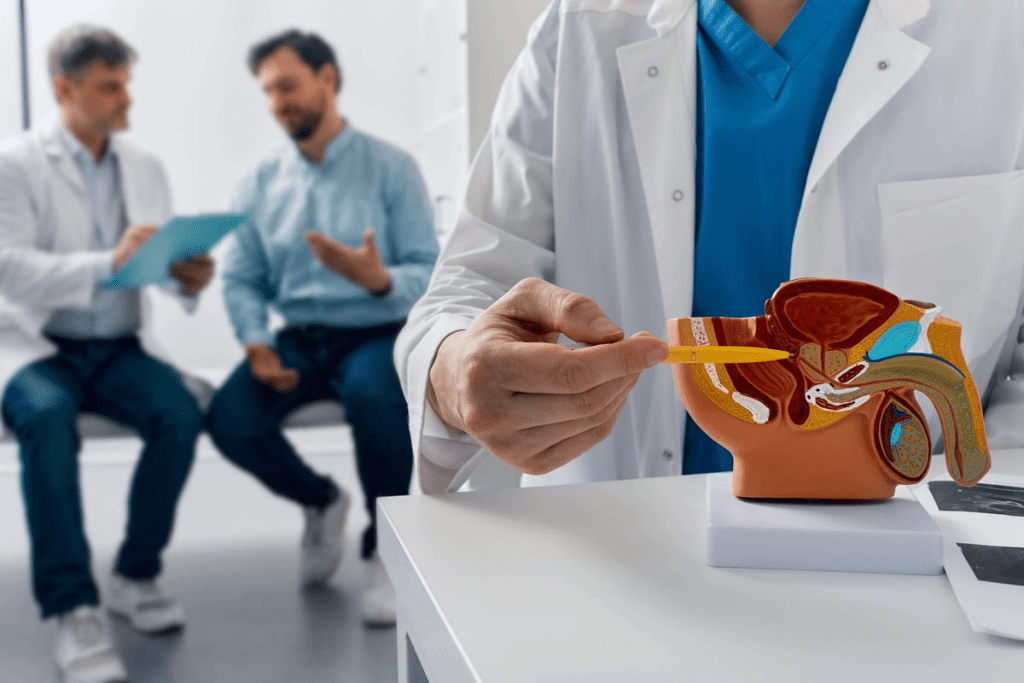Last Updated on November 25, 2025 by

Transurethral Resection of the Prostate (TURP procedure) is a common surgery for Benign Prostatic Hyperplasia (BPH). It helps with urinary issues, but raises questions about prostate growth after the surgery. Can the prostate grow back after a TURP? Learn the life expectancy after TURP surgery facts. The negative reality is that tissue can regrow. Crucial insight.
Research shows that prostate volume progression after TURP depends on several factors. These include age, testosterone levels, PSA, TNF-α, and TGF-β. Studies reveal that most men see their prostate grow back, causing worse urinary symptoms within 7 to 10 years.
It’s important to understand these factors for better long-term management. We look into what prostate regrowth means for those who have had a TURP surgical procedure.
The TURP procedure helps by removing extra prostate tissue to improve urine flow. But it’s important to know if the prostate can grow back. To understand this, we need to know how TURP works and its effects on the prostate.
TURP, or Transurethral Resection of the Prostate, is a surgery for an enlarged prostate. It removes parts of the prostate that block urine flow. A surgeon uses a resectoscope through the urethra to do this.
This surgery aims to fix problems like weak urine flow and needing to urinate often. Knowing what happens before and after TURP is key for patients. Before, they faced big urinary issues. After, most see their symptoms improve. But there’s a chance the prostate could grow back.

The body can grow back tissues, including the prostate. After TURP, the prostate can grow again. This growth depends on age, hormones, and health.
Studies show that prostate growth after TURP is linked to age and hormones. They also found links to PSA and other growth factors. This means recovering from TURP surgery is not just about the first few weeks. It’s also about watching for growth over time.
How fast the prostate grows back varies from person to person. Age, starting prostate size, and hormones play a big role. Knowing these factors helps manage expectations and plan for future care.
The rate and extent of prostate regrowth after TURP surgery differ among people. Knowing what affects this growth is key to better care and follow-up plans.
Age is a big factor in prostate regrowth. Older men tend to grow their prostate more because of aging and hormonal changes. Men over 65 are more likely to see significant growth.
Testosterone levels play a big role in prostate growth. It makes the prostate grow, and different levels can change how fast it grows. Research shows that higher testosterone can lead to faster growth.

PSA levels help check prostate health and growth. High PSA levels after TURP might mean growth or other issues. It’s important to keep an eye on PSA levels to catch growth early. Key points include:
Growth factors like TNF-α and TGF-β help the prostate grow back. They control how cells grow and change, helping the prostate grow. Knowing how these factors work can help find new treatments. Important points are:
Understanding what affects prostate regrowth helps doctors give better care after TURP surgery. This improves patients’ lives.
Studies show trends in prostate regrowth after TURP. Knowing these trends helps patients and doctors plan better.
Reoperation rates after TURP vary by technique. Bipolar TURP might have lower complication rates than monopolar. Both methods have good long-term results.
“Choosing between monopolar and bipolar TURP depends on the patient and the surgeon,” a study says. Monopolar TURP’s reoperation rate is 5% to 15% in 5 years. Bipolar TURP’s rate is 3% to 10% in the same time.
Enucleation, like HoLEP, might have lower reoperation rates than TURP. This is because more prostate tissue is removed. A study found HoLEP has a lower reoperation rate than TURP.
Regrowth after TURP varies by person. It can start 2-3 years after surgery. Most regrowth happens in the first 5 years.
Age, hormones, and prostate size affect regrowth rates. Regular check-ups with doctors are key to managing prostate health.
“Long-term follow-up is vital for TURP patients,” a study concludes. Knowing about regrowth rates helps patients make better health choices.
TURP surgery can greatly improve urinary symptoms. But, it’s important to know about prostate regrowth and its effects on life quality. We need to look at how TURP surgery affects life expectancy and how to handle any symptoms that come back.
Prostate tissue can grow back after TURP, causing urinary symptoms again. This can really affect a person’s quality. Symptoms like weak urine flow and needing to urinate often are common. It’s key to manage these symptoms well to keep a good quality.
Dealing with symptoms that come back after TURP surgery needs a few steps. A healthy lifestyle, like eating right and exercising, helps a lot. Doctors might also prescribe medicine to help with symptoms or other health issues.
Regular check-ups are important to watch for prostate regrowth and symptoms. These visits include digital rectal exams and PSA tests. Spotting regrowth early helps in getting better treatment.
Deciding on treatment again depends on how bad the symptoms are and how they affect life. If symptoms are severe, another TURP or other surgeries might be needed. Talking to a doctor is key to figuring out the best treatment.
Knowing about prostate regrowth and the need for follow-up care helps manage health after TURP surgery. Handling symptoms well and acting fast can greatly improve life quality in the long run.
Knowing the TURP step-by-step procedure is key for patients to manage their health well after surgery. We’ve talked about how recovering from TURP surgery means watching out for prostate regrowth. It also means being active in checking your health.
After TURP surgery, it’s important for patients to work closely with their doctors. This helps address any concerns and improves outcomes. Regular check-ups can spot any issues early, keeping patients’ quality of life high.
Being informed and proactive helps patients deal with prostate regrowth challenges. We stress the need for a complete approach to health management after TURP. This empowers patients to control their well-being and get the best results.
The chance of prostate regrowth after TURP depends on several things. These include age, hormones, and PSA levels. Older men are more likely to see regrowth.
Regrowth time varies, but studies show it can happen in 5-10 years. Regular check-ups are key to catching regrowth early.
Signs of regrowth include trouble urinating, weak flow, and needing to pee more often. Seeing your doctor is important if you notice these.
Doctors use PSA tests, digital exams, and imaging such as ultrasound or MRI to diagnose regrowth.
Treatments include medicines, small procedures, or another TURP. The right choice depends on how bad the symptoms are and how much the prostate has grown.
Lifestyle changes can’t stop regrowth, but can help with symptoms. Eating well, exercising, and managing stress are good for your prostate.
It’s important to see your doctor regularly to check for regrowth. How often you go depends on your situation.
Both monopolar and bipolar TURP treat BPH well, but regrowth risks might differ. Bipolar TURP might have fewer complications.
You might need more treatment if regrowth causes big problems. Your doctor will decide based on your case.
Repeat TURP has similar risks to the first time, like bleeding and infection. But risks might be higher. Your doctor will talk about the risks and benefits.
Subscribe to our e-newsletter to stay informed about the latest innovations in the world of health and exclusive offers!